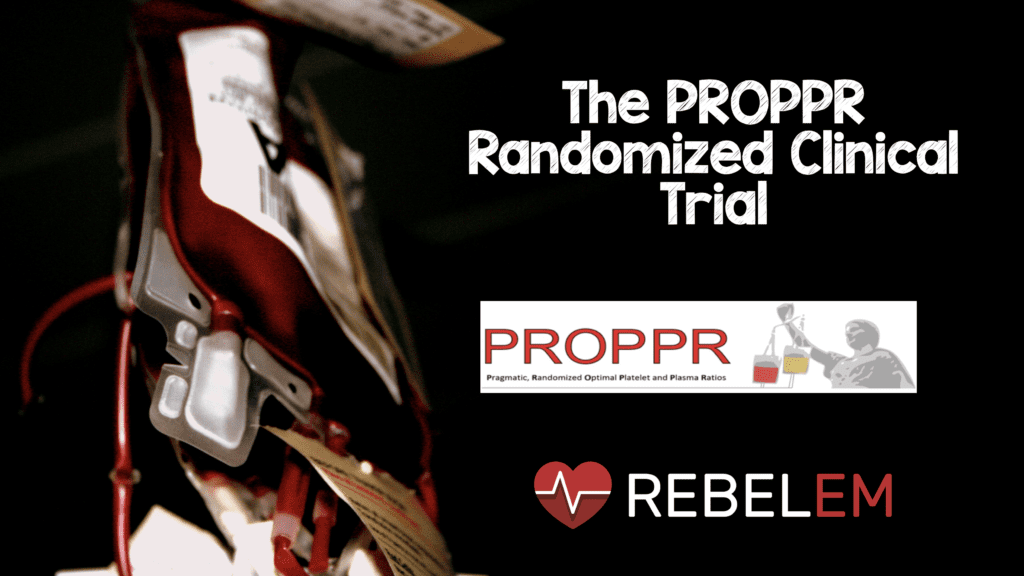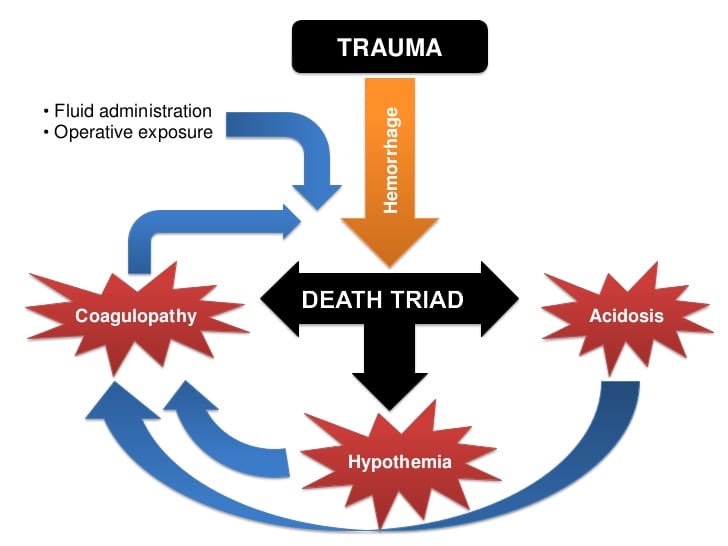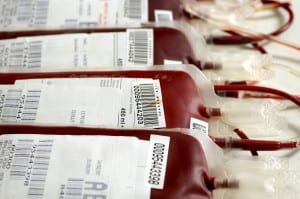

The Pragmatic, Randomized Optimal Platelet and Plasma Ratios (PROPPR) Trial was designed to address the effectiveness and safety of 1:1:1 transfusion ratio vs 1:1:2 in patients with trauma who were predicted to receive a massive transfusion.
What is Damage Control Resuscitation (DCR)? [1]
Damage Control Resuscitation (DCR) is the concept of rapid hemorrhage control through:
- Permissive Hypotension
- Hemostatic Resuscitation (Massive Transfusion Protocol)
- Hemorrhage Control (Damage Control Surgery)
Early administration of blood products in a balanced ratio (1:1:1 for units of plasma to platelets to red blood cells helps treat intravascular volume deficits, acute coagulopathy of trauma, preserve oxygen-carrying capacity, and prevention of dilutional coagulopathy.

What is the definition of a massive transfusion? [2]
Historically, massive transfusion is defined as the replacement of > 10 Units of PRBCs within 24 hours or arbitrarily defined as:
- The replacement of a patient’s total blood volume in less than 24 hours
- The acute administration of more than half the patient’s estimated blood volume over 3 hours

What is the Basic Breakdown of The PROPPR Randomized Clinical Trial? JAMA Feb 2015

What they Did:
- Determine the effectiveness and safety of transfusing patients with severe trauma and major bleeding using plasma, platelets, and red blood cells in a 1:1:1 ratio vs 1:1:2 ratio
- Phase 3, multisite, randomized clinical trial of 680 severely injured patients
- 12, level 1 trauma centers in North America
Primary Outcome:
- 24-hour and 30-day all-cause mortality
Secondary Outcomes:
- Time to hemostasis
- Blood product volumes transfused
- Complications
- Incidence of surgical procedures
- Functional status
Results:
- No statistically significant difference in mortality at 24 hours or at 30 days
- Exsanguination in first 24 hours (secondary outcome) significantly decreased in the 1:1:1 group vs 1:1:2 group (9.2% vs 14.6%; p = 0.03)
- More patients achieved hemostasis in the 1:1:1 group vs 1:1:2 group (86% vs 78%; p = 0.006)
- More plasma (Median 7 Units vs 5 Units) and platelets (Median 12 Units vs 6 Units) were used in the 1:1:1 ratio vs 1:1:2 ratio
- No difference in complications between the two strategies
Limitations:
- This study was appropriately powered to detect a 10% difference in mortality between the 1:1:1 and 1:1:2 groups, however the study could not definitively establish a benefit < 10%
- Physicians not blinded once transfusion protocol begun
- Unable to completely exclude patients with an unsurvivable brain injury (23% of deaths at 24 hrs and 38% of deaths at 30 days)
Study Conclusion: Among patients with severe trauma and major bleeding, early administration of plasma, platelets, and red blood cells in a 1:1:1 ratio vs 1:1:2 ratio did not result in significant differences in mortality at 24 hours or 30 days. However, more patients in the 1:1:1 group achieved hemostasis and fewer experienced death due to exsanguination at 24 hours.
Buzz on Twitter
Take Home Message
Ultimately, this was an underpowered study to determine < 10% mortality benefit at 24 hours and 30 days, however the 1:1:1 transfusion strategy decreases death from exsanguination at 24 hours, achieves more rapid hemostasis, and has no additional complications associated with it.
References:
- Pohlman TH et al. Damage Control Resuscitation. Blood Rev 2015. PMID: 25631636
- Hardy JF et al. Massive Transfusion and Coagulopathy: Pathophysiology and Implications for clinical Management. Can J Anaesth 2014. PMID: 15064258
- Holcomb JB et al. Transfusion of Plasma, Platelets, and Red Blood Cells in a 1:1:1 vs a 1:1:2 ratio and Mortality in Patients with Severe Trauma: The PROPPR Randomized Clinical Trial. JAMA 2015. PMID: 25647203
For More Thoughts Check Out:
- Rory Spiegel at EM Nerd: The Adventure of the Blanched Soldier
- Ryan Radecki at EM Literature of Note: The Fixed-Ratio Massive Transfusion Answer
- Richard Carden at St. Emlyn’s: JC: Getting the Balance Right: The PROPPR Trial
- The Bottom Line: PROPPR: Transfusion of Plasma, Platelets, and Red Blood Cells in a 1:1:1 vs a 1:1:2 Ratio and Mortality in Patients with Severe Trauma. The PROPPR Randomized Clinical Trial
- Scott Weingart at EMCrit: Podcast 144 – The PROPPR Trial with John Holcomb
- Ken Milne at The SGEM: SGEM#109 – One Platelet, One Plasma and One RBC – PROPPR Trial
The post The PROPPR Randomized Clinical Trial appeared first on REBEL EM - Emergency Medicine Blog.
